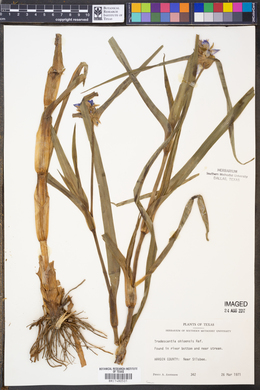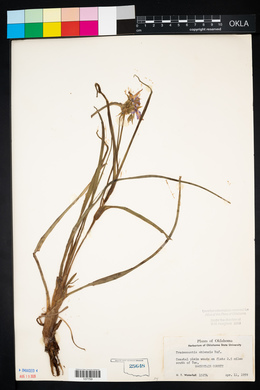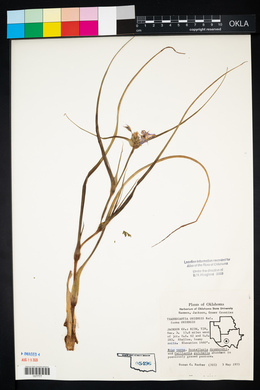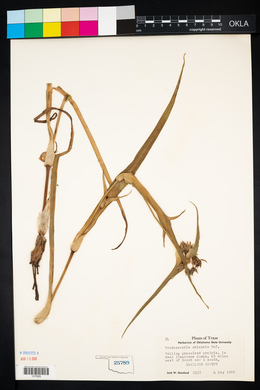Tradescantia ohiensis
|
|
|
|
Family: Commelinaceae
Bluejacket, more...Ohio spiderwort
[Tradescantia canaliculata Raf., moreTradescantia foliosa Small, Tradescantia incarnata Small, Tradescantia ohiensis f. pilosa Waterf., Tradescantia ohiensis var. foliosa (Small) D.T.MacRoberts, Tradescantia reflexa Raf., Tradescantia reflexa f. albiflora A.D.Slavin & Nieuwl.] |
Herbs, erect or ascending, rarely rooting at nodes. Stems 15--115 cm; internodes glabrous or occasionally pilose, glaucous. Leaves spirally arranged, sessile, forming acute angle with stem, arcuate; blade linear to linear-lanceolate, 5--45 ´ 0.4--4.5 cm (distal leaf blades equal to or narrower than sheaths when sheaths opened, flattened), apex acuminate, glaucous, usually glabrous, sometimes pilose near sheath. Inflorescences terminal and often axillary; bracts foliaceous. Flowers distinctly pedicillate; pedicels 0.7--3 cm, glabrous; sepals glaucous, 4--15 mm, glabrous or with apical tuft of eglandular hairs; petals distinct, deep blue to rose, rarely white, broadly ovate, not clawed, 0.8--2 cm; stamens free; filaments bearded. Capsules 4--6 mm. Seeds 2--3 mm. 2n = 12, 24. Flowering late winter--fall (Feb (Fla.)--Sep). Roadsides, railroad rights-of-way, fields, thickets, less commonly in woods, occasionally along streams; Ont.; Ala., Ark., Conn., Del., D.C., Fla., Ga., Ill., Ind., Iowa, Kans., Ky., La., Md., Mass., Mich., Minn., Miss., Mo., Nebr., N.J., N.Y., N.C., Ohio, Okla., Pa., R.I., S.C., Tenn., Tex., Va., W.Va., Wis. Tradescantia ohiensis is the most common and widespread species in the United States. It hybridizes with many of the other species. Tradescantia ohiensis var. foliosa (Small) MacRoberts has been recognized for the forms with pilose leaves and sheaths (D. T. MacRoberts 1977). I have found such plants scattered among populations of glabrous plants, and I do not consider them worthy of formal taxonomic status. The following hybrids are known: Tradescantia ohiensis ´ T. gigantea, in Louisiana and Texas; T. ohiensis ´ T. hirsuticaulis, Arkansas; T. ohiensis ´ T. occidentalis, Arkansas, Louisiana; T. ohiensis ´ T. ozarkana, Arkansas; T. ohiensis ´ T. paludosa, Louisiana (reported by MacRoberts, 1980); T. ohiensis ´ T. roseolens, Alabama, Florida; T. ohiensis ´ T. subaspera, Alabama, Georgia, Mississippi, North Carolina, South Carolina, Tennessee, Virginia, West Virginia; and T. ohiensis ´ T. virginiana, Georgia, Kentucky, Maryland, Mississippi, North Carolina, South Carolina, and Virginia.
Perennial herb to 1 m tall Stem: slender, erect or ascending, seldom rooting at the nodes, usually branched, covered with a whitish waxy coating (glaucous). Leaves: spirally arranged, 4 - 45 cm long, usually less than 1 cm wide, linear to lance-shaped with a pointed tip, covered with a whitish waxy coating, the base wrapping around the stem to form a sheath. The blade width equals the circumference of the sheath. Inflorescence: terminating the main stem or branches, solitary, subtended by leaf-like bracts. Flowers: borne on a hairless stalk 0.7 - 3 cm long. The three sepals are 0.4 - 1.5 cm long, hairless or hairy at the tip, often red-margined, and covered with a whitish waxy coating. The three petals deep blue to rose, sometimes white, rarely variegated or red, 0.8 - 2 cm long, not clawed. Stamens are unattached, filaments are bearded, the style is slender, and the stigma is head-like. Fruit: a three-valved and three-chambered capsule 4 - 6 mm long, containing six 2 - 3 mm long seeds. Similar species: The Tradescantia species found in the Chicago Region can most easily be distinguished by the size of their leaves and presence or type of hairs on the sepals, flower stalks and bracts. Tradescantia subaspera leaf blades are wider than the sheaths (over 2 cm) and less than 10x as long as wide; the sepals and flower stalks are hairy. Tradescantia virginiana leaf blades are as wide as or narrower than the sheaths (less than 2 cm) and more than 10x as long as wide; the sepals, flower stalks and bracts are hairy. Tradescantia bracteata leaf blades are as wide as or narrower than the sheath (less than 2 cm) and more than 10x as long as wide; the sepals and flower stalks are covered by a mixture of non-glandular and glandular hairs, but the bracts are hairless. Flowering: mid May to late October Habitat and ecology: This species commonly grows in sandy black oak savannas, but is also found in disturbed prairies and railroad gravel. Occurence in the Chicago region: native Notes: This is the most common species of Tradescantia found in the United States, and can hybridize with other species in the genus. Etymology: Tradesecantia is named after John Tradescant (d. 1638), the gardener of King Charles I. Ohiensis means "from Ohio." Author: The Morton Arboretum Stem slender, straight or nearly so, often branched, 4-10 dm, glabrous and glaucous; lvs narrowly linear, flat, firm, glabrous, glaucous, usually under 1 cm wide, conspicuously dilated into a sheath; cymes solitary, terminating the stem and branches; pedicels 7-25 cm, glabrous; sep glaucous, 8-12 mm, often red-margined, glabrous throughout or occasionally minutely pilose with eglandular hairs at the tip; pet blue or rose (white), 1-2 cm; 2n=12, 24. Meadows, thickets, and prairies; Mass. to Minn., s. to Fla. and Tex., commonest in the Middle West. (T. barbata; T. canaliculata; T. reflexa) Gleason, Henry A. & Cronquist, Arthur J. 1991. Manual of vascular plants of northeastern United States and adjacent Canada. lxxv + 910 pp. ©The New York Botanical Garden. All rights reserved. Used by permission. From Flora of Indiana (1940) by Charles C. Deam This species prefers the open and is generally found in dry, sandy or gravelly soil, along roadsides, on sand hills and high banks of lakes, and on the dunes. It is rarely found in swampy places but is frequent in moist, prairie habitats. This is a rank growing species with several color forms which have been named and which persist under cultivation. …… Indiana Coefficient of Conservatism: C = 3 Wetland Indicator Status: FACU |
|
|
|



























































































